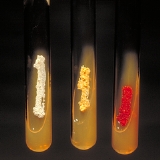
Micromonospora
Encyclopedia
Micromonospora is a genus of bacteria of the family Micromonosporaceae
. They are gram-positive
, spore
-forming, generally aerobic
, and form a branched mycelium
; they occur as saprotrophic forms in soil and water. Various species are sources of aminoglycoside
antibiotics, which spellings often ends by micin, unlike most other aminoglycoside names that end with mycin to highlight the very different species from which they originate (e.g. neomycin
and streptomycin
, produced by Streptomyces spp.
).
Micromonosporaceae
Micromonosporaceae is a family of bacteria of the order Actinomycetales. They are gram-positive, spore-forming soil organisms that form a true mycelium....
. They are gram-positive
Gram-positive
Gram-positive bacteria are those that are stained dark blue or violet by Gram staining. This is in contrast to Gram-negative bacteria, which cannot retain the crystal violet stain, instead taking up the counterstain and appearing red or pink...
, spore
Spore
In biology, a spore is a reproductive structure that is adapted for dispersal and surviving for extended periods of time in unfavorable conditions. Spores form part of the life cycles of many bacteria, plants, algae, fungi and some protozoa. According to scientist Dr...
-forming, generally aerobic
Aerobic organism
An aerobic organism or aerobe is an organism that can survive and grow in an oxygenated environment.Faculitative anaerobes grow and survive in an oxygenated environment and so do aerotolerant anaerobes.-Glucose:...
, and form a branched mycelium
Mycelium
thumb|right|Fungal myceliaMycelium is the vegetative part of a fungus, consisting of a mass of branching, thread-like hyphae. The mass of hyphae is sometimes called shiro, especially within the fairy ring fungi. Fungal colonies composed of mycelia are found in soil and on or within many other...
; they occur as saprotrophic forms in soil and water. Various species are sources of aminoglycoside
Aminoglycoside
An aminoglycoside is a molecule or a portion of a molecule composed of amino-modifiedsugars.Several aminoglycosides function as antibiotics that are effective against certain types of bacteria...
antibiotics, which spellings often ends by micin, unlike most other aminoglycoside names that end with mycin to highlight the very different species from which they originate (e.g. neomycin
Neomycin
Neomycin is an aminoglycoside antibiotic that is found in many topical medications such as creams, ointments, and eyedrops. The discovery of Neomycin dates back to 1949. It was discovered in the lab of Selman Waksman, who was later awarded the Nobel Prize in Physiology and medicine in 1951...
and streptomycin
Streptomycin
Streptomycin is an antibiotic drug, the first of a class of drugs called aminoglycosides to be discovered, and was the first antibiotic remedy for tuberculosis. It is derived from the actinobacterium Streptomyces griseus. Streptomycin is a bactericidal antibiotic. Streptomycin cannot be given...
, produced by Streptomyces spp.
Streptomyces
Streptomyces is the largest genus of Actinobacteria and the type genus of the family Streptomycetaceae. Over 500 species of Streptomyces bacteria have been described. As with the other Actinobacteria, streptomycetes are gram-positive, and have genomes with high guanine and cytosine content...
).
Species
- Micromonospora aurantiaca
- Micromonospora carbonacea
- Micromonospora chalcea
- Micromonospora chersina
- Micromonospora citrea
- Micromonospora coerulea
- Micromonospora echinaurantiaca
- Micromonospora echinofusca
- Micromonospora echinosporaMicromonospora echinosporaMicromonospora echinospora is a species of bacteria that is known for producing the enediyne antibiotic calicheamicins....
- produces highly toxic DNA splicing calicheamicinCalicheamicinThe calicheamicins are a class of enediyne antibiotics derived from the bacterium Micromonospora echinospora, with calicheamicin γ1 being the most notable. It was isolated originally from a rock collected by a Scripps Research Institute chemist while hiking in Waco, Texas. It is extremely toxic to...
s - Micromonospora fulviviridis
- Micromonospora gallica
- Micromonospora halophytica
- Micromonospora inositola - produces the antibiotic sisomicinSisomicinSisomicin is an aminoglycoside antibiotic....
- Micromonospora inyonensis - produces the antibiotics mutamicin and netilmicinNetilmicinNetilmicin is a member of the aminoglycoside family of antibiotics. These antibiotics have the ability to kill a wide variety of bacteria. Netilmicin is not absorbed from the gut and is therefore only given by injection or infusion...
- Micromonospora nigra
- Micromonospora olivasterospora
- Micromonospora pallida
- Micromonospora peucetia
- Micromonospora purpureochromogenes - produces the antibiotic gentamicinGentamicinGentamicin is an aminoglycoside antibiotic, used to treat many types of bacterial infections, particularly those caused by Gram-negative organisms. However, gentamicin is not used for Neisseria gonorrhoeae, Neisseria meningitidis or Legionella pneumophila...
- Micromonospora rosaria
- Micromonospora sagamiensis
- Micromonospora viridifaciens

